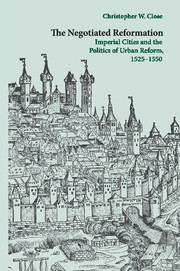Book contents
- Frontmatter
- Contents
- List of Abbreviations
- Acknowledgments
- Map One South German Imperial Cities ca. 1525
- Map Two Imperial Cities in Upper and Eastern Swabia
- Introduction
- 1 Consultation and the Urban Hierarchy
- 2 Imperial Cities and Collective Politics
- 3 Preachers, Consultation, and the Spread of Urban Reform in Southern Germany
- 4 The Urban Reformation in Donauwörth
- 5 The Urban Reformation in Kaufbeuren
- 6 Negotiation and the Rural Reformation in Eastern Swabia
- 7 Eastern Swabia and the Schmalkaldic War
- Conclusion
- Bibliography
- Index
- References
1 - Consultation and the Urban Hierarchy
Published online by Cambridge University Press: 26 December 2009
- Frontmatter
- Contents
- List of Abbreviations
- Acknowledgments
- Map One South German Imperial Cities ca. 1525
- Map Two Imperial Cities in Upper and Eastern Swabia
- Introduction
- 1 Consultation and the Urban Hierarchy
- 2 Imperial Cities and Collective Politics
- 3 Preachers, Consultation, and the Spread of Urban Reform in Southern Germany
- 4 The Urban Reformation in Donauwörth
- 5 The Urban Reformation in Kaufbeuren
- 6 Negotiation and the Rural Reformation in Eastern Swabia
- 7 Eastern Swabia and the Schmalkaldic War
- Conclusion
- Bibliography
- Index
- References
Summary
In mid-October 1531, an urgent letter arrived in the city council chamber of the imperial city Ulm. Penned by magistrates in Constance, an imperial city in southwestern Upper Swabia, the missive requested Ulm's help in resolving a legal conflict between Constance's council and several Dominican monks. The friars had left the city in protest after the council's introduction of evangelical religious reform, whereupon Constance's magistrates appropriated several vineyards owned by the monastery. The Dominicans now sought redress through legal action in imperial courts. As part of its defense strategy, Constance's council forwarded Ulm a copy of its proposed reply to the friars. Since “this dispute affects and concerns not just us, but also you and all other members of the [Schmalkaldic League],” the council members wrote, “please offer your advice concerning what should be changed or eliminated from this response, or whether we should proceed in another way.” Constance's magistrates asked for guidance “in the hopes that you and other cities might help us avoid a declaration of outlawry.”
Ulm's magistrates responded in two ways. The council commissioned its leading theologian, Martin Frecht, to compose a letter of advice for Constance. It forwarded this to Constance's magistrates, who “altered the protestation concerning the preacher monks according to [Ulm's] recommendation.” At Constance's request, Ulm also wrote two other evangelical imperial cities – Nuremberg and Strasbourg – asking for their aid in resolving the conflict.
- Type
- Chapter
- Information
- The Negotiated ReformationImperial Cities and the Politics of Urban Reform, 1525–1550, pp. 20 - 56Publisher: Cambridge University PressPrint publication year: 2009

